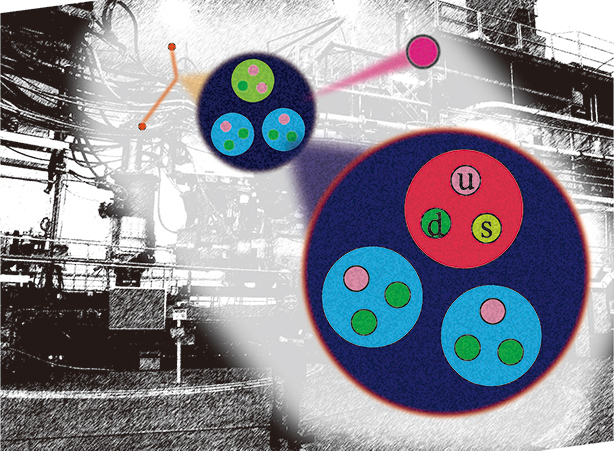The absence of direct evidence does not always negate a hypothesis. In a joint study including Kyoto and Tohoku Universities, the existence of a mysteriously uncharged nucleus could not be ruled out.
The net charge of an atom depends on the charge difference between the protons in the nucleus and surrounding electrons. The nucleus, on the one hand, houses protons and non-charged neutrons, implying that the nucleus will always be positively charged.
Author Toshiyuki Gogami, on the other hand, asked himself, "What would it take to produce a nucleus with no charge?"
Neutrons and protons, collectively termed nucleons, consist of up and down quarks. The lambda particle Λ, in contrast, has a so-called strange quark and no electrical charge. It follows then a three-body system of Λnn, or lambda-neutron-neutron, would have no charge.
Despite a limitation in known theories of nuclear physics, indirect evidence of the close relationship between the Λnn production probability and nucleon interactions has helped the team deduce Λnn's possible existence.
The team used high-quality electron beams to convert the lambda particle Λ from a proton in a target nucleus. When the production of Λ generates strange and anti-strange quarks, a meson containing an anti-strange quark is simultaneously emitted from the nucleus.
Gogami and his team realize that the statistical significance in their results need to improve for them to be able to make any definite claims. Nevertheless, by tweaking their electron beams and fine-tuning the production probability, they believe the search for the purely neutral nucleus may finally charge up.

【DOI】https://doi.org/10.1093/ptep/ptab158
【KURENAI ACCESS URL】http://hdl.handle.net/2433/268734
K N Suzuki, T Gogami, B Pandey, K Itabashi, S Nagao, K Okuyama, S N Nakamura, L Tang, D Abrams, T Akiyama, D Androic, K Aniol, C Ayerbe Gayoso, J Bane, S Barcus, J Barrow, V Bellini, H Bhatt, D Bhetuwal, D Biswas, A Camsonne, J Castellanos, J-P Chen, J Chen, S Covrig, D Chrisman, R Cruz-Torres, R Das, E Fuchey, K Gnanvo, F Garibaldi, T Gautam, J Gomez, P Gueye, T J Hague, O Hansen, W Henry, F Hauenstein, D W Higinbotham, C E Hyde, M Kaneta, C Keppel, T Kutz, N Lashley-Colthirst, S Li, H Liu, J Mammei, P Markowitz, R E McClellan, F Meddi, D Meekins, R Michaels, M Mihovilovič, A Moyer, D Nguyen, M Nycz, V Owen, C Palatchi, S Park, T Petkovic, S Premathilake, P E Reimer, J Reinhold, S Riordan, V Rodriguez, C Samanta, S N Santiesteban, B Sawatzky, S Širca, K Slifer, T Su, Y Tian, Y Toyama, K Uehara, G M Urciuoli, D Votaw, J Williamson, B Wojtsekhowski, S A Wood, B Yale, Z Ye, J Zhang, X Zheng (2022). The cross-section measurement for the ³H(e, e′K⁺)nnΛ reaction. Progress of Theoretical and Experimental Physics, 2022(1):013D01.





